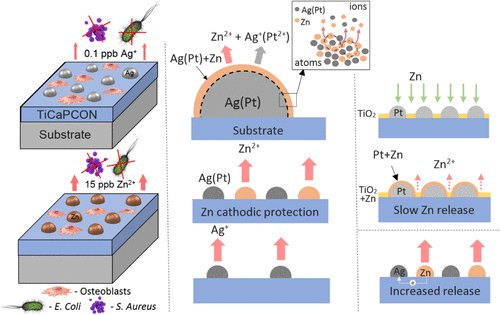当前位置:
X-MOL 学术
›
ACS Appl. Mater. Interfaces
›
论文详情
Our official English website, www.x-mol.net, welcomes your
feedback! (Note: you will need to create a separate account there.)
Antibacterial Performance of TiCaPCON Films Incorporated with Ag, Pt, and Zn: Bactericidal Ions Versus Surface Microgalvanic Interactions
ACS Applied Materials & Interfaces ( IF 8.3 ) Pub Date : 2018-07-03 00:00:00 , DOI: 10.1021/acsami.8b06671 V. A. Ponomarev 1 , I. V. Sukhorukova 1 , A. N. Sheveyko 1 , E. S. Permyakova 1 , A. M. Manakhov 1 , S. G. Ignatov 2 , N. A. Gloushankova 3 , I. Y. Zhitnyak 3 , O. I. Lebedev 4 , J. Polčak 5, 6 , A. M. Kozmin 7 , D. V. Shtansky 1
ACS Applied Materials & Interfaces ( IF 8.3 ) Pub Date : 2018-07-03 00:00:00 , DOI: 10.1021/acsami.8b06671 V. A. Ponomarev 1 , I. V. Sukhorukova 1 , A. N. Sheveyko 1 , E. S. Permyakova 1 , A. M. Manakhov 1 , S. G. Ignatov 2 , N. A. Gloushankova 3 , I. Y. Zhitnyak 3 , O. I. Lebedev 4 , J. Polčak 5, 6 , A. M. Kozmin 7 , D. V. Shtansky 1
Affiliation

|
It is very important to prevent bacterial colonization at the early postoperative stages. There are four major strategies and their corresponding types of antibacterial surfaces specifically designed to fight infection: bactericide release, anti-adhesion, pH-sensitive, and contact-killing. Herein, we aimed at determining the antibacterial efficiency of different types of bactericidal ions and revealing the possible contribution of surface microgalvanic effects arising from a potential difference on heterogeneous surfaces. We considered five types of TiCaPCON films, with Ag, Zn, Pt, Ag + Zn, and Pt + Zn nanoparticles (NPs) on their surface. The Ag-modified film demonstrated a pronounced antibacterial effect at a very low Ag ion concentration of 0.11 ppb in physiological solution that was achieved already after 3 h of immersion in Escherichia coli (E. coli) bacterial culture. The Zn-containing sample also showed a noticeable antibacterial effect against E. coli and Staphylococcus aureus (S. aureus) strains, wherein the concentration of Zn ions was 2 orders of magnitude higher (15 ppb) compared with the Ag ions. The presence of Ag NPs accelerated the leaching of Zn ion out of the TiCaPCON–Ag–Zn film, but no synergistic effect of the simultaneous presence of the two bactericidal components was observed. After the incubation of the samples with Ag, Zn, and Ag + Zn NPs in E. coli and S. aureus suspensions for 24 and 8 h, respectively, all bacterial cells were completely inactivated. The Pt-containing film showed a very low Pt ion release, and therefore the contribution of this type of ions to the total bactericidal effect could be neglected. The results of the electrochemical studies and Kelvin probe force microscopy indicated that microgalvanic couples were formed between the Pt NPs and the TiCaPCON film, but no noticeable antibacterial effect against either E. coli or S. aureus strains was observed. All ion-modified samples provided good osteoblastic cell attachment, spreading, and proliferation and therefore were concluded to be nontoxic for cells. In addition, the TiCaPCON films with Ag, Pt, and Zn NPs on their surface demonstrated good osteoconductive characteristics.
中文翻译:

掺有Ag,Pt和Zn的TiCaPCON薄膜的抗菌性能:杀菌离子与表面微电流相互作用
预防术后早期细菌定植非常重要。专为抵抗感染而设计的抗菌表面有四种主要策略及其相应类型:杀菌剂释放,抗粘连,pH敏感和接触杀灭。在本文中,我们旨在确定不同类型杀菌离子的抗菌效率,并揭示由异质表面上的电势差引起的表面微电流效应的可能贡献。我们考虑了五种类型的TiCaPCON膜,其表面上具有Ag,Zn,Pt,Ag + Zn和Pt + Zn纳米颗粒(NPs)。Ag改性膜在生理溶液中浸入0.11 ppb的极低Ag离子浓度时表现出显着的抗菌作用,这是在将其浸入水中3小时后即可实现的。大肠杆菌(E. coli)细菌培养。含锌样品还显示出对大肠杆菌和金黄色葡萄球菌(S. aureus)菌株的显着抗菌作用,其中锌离子的浓度比银离子高2个数量级(15 ppb)。Ag NPs的存在加速了Zn离子从TiCaPCON–Ag–Zn膜中的浸出,但没有观察到同时存在两种杀菌成分的协同作用。在大肠杆菌和金黄色葡萄球菌中将样品与Ag,Zn和Ag + Zn NP一起孵育后分别悬浮24小时和8小时,所有细菌细胞都被完全灭活。含Pt的膜显示出极低的Pt离子释放,因此可以忽略这类离子对总杀菌作用的贡献。电化学研究和开尔文探针力显微镜的结果表明,在Pt NP和TiCaPCON膜之间形成了微电偶,但未观察到对大肠杆菌或金黄色葡萄球菌菌株的显着抗菌作用。所有经离子修饰的样品均具有良好的成骨细胞附着,扩散和增殖能力,因此被认为对细胞无毒。另外,在其表面上具有Ag,Pt和Zn NP的TiCaPCON膜表现出良好的骨传导特性。
更新日期:2018-07-03
中文翻译:

掺有Ag,Pt和Zn的TiCaPCON薄膜的抗菌性能:杀菌离子与表面微电流相互作用
预防术后早期细菌定植非常重要。专为抵抗感染而设计的抗菌表面有四种主要策略及其相应类型:杀菌剂释放,抗粘连,pH敏感和接触杀灭。在本文中,我们旨在确定不同类型杀菌离子的抗菌效率,并揭示由异质表面上的电势差引起的表面微电流效应的可能贡献。我们考虑了五种类型的TiCaPCON膜,其表面上具有Ag,Zn,Pt,Ag + Zn和Pt + Zn纳米颗粒(NPs)。Ag改性膜在生理溶液中浸入0.11 ppb的极低Ag离子浓度时表现出显着的抗菌作用,这是在将其浸入水中3小时后即可实现的。大肠杆菌(E. coli)细菌培养。含锌样品还显示出对大肠杆菌和金黄色葡萄球菌(S. aureus)菌株的显着抗菌作用,其中锌离子的浓度比银离子高2个数量级(15 ppb)。Ag NPs的存在加速了Zn离子从TiCaPCON–Ag–Zn膜中的浸出,但没有观察到同时存在两种杀菌成分的协同作用。在大肠杆菌和金黄色葡萄球菌中将样品与Ag,Zn和Ag + Zn NP一起孵育后分别悬浮24小时和8小时,所有细菌细胞都被完全灭活。含Pt的膜显示出极低的Pt离子释放,因此可以忽略这类离子对总杀菌作用的贡献。电化学研究和开尔文探针力显微镜的结果表明,在Pt NP和TiCaPCON膜之间形成了微电偶,但未观察到对大肠杆菌或金黄色葡萄球菌菌株的显着抗菌作用。所有经离子修饰的样品均具有良好的成骨细胞附着,扩散和增殖能力,因此被认为对细胞无毒。另外,在其表面上具有Ag,Pt和Zn NP的TiCaPCON膜表现出良好的骨传导特性。











































 京公网安备 11010802027423号
京公网安备 11010802027423号